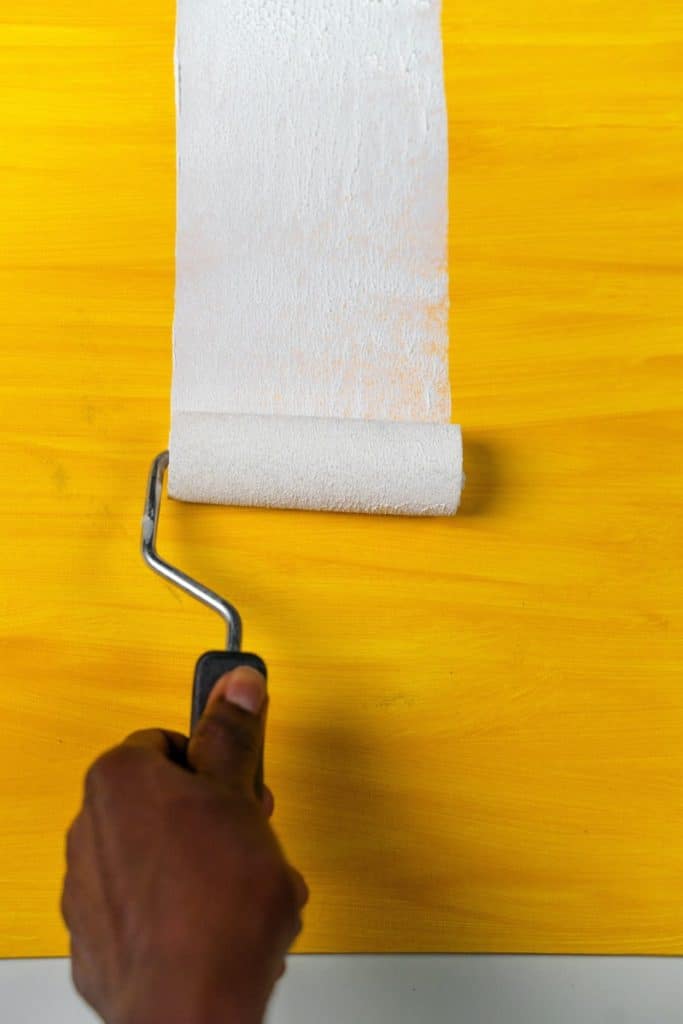
You can have it in any color you want, as long as you paint it. What if you repainted your whole house, can you paint or repaint your roof as well to match? What if your roof is getting old and a little damaged, can you extend its lifespan? These are some common questions people have when they think about painting their roofs.
Can a roof be painted? Yes and no. Painting your roof is sometimes recommended because it can provide added protection, can lower your energy cost, add years to your roof lifespan, and can add to the appeal of your home. However, disadvantages come with painting some roofing materials like asphalt and wood shingles.
There are different types of paint you can use depending on your roofing material. For better performance, you can choose roof coatings instead of simple roof paints. There are pros and cons to each, different effects depending on the color and composition, and cost differences.
Pros and Cons of Painting Your Roof

Painting your roof comes with benefits but it also comes with disadvantages. Choosing the wrong paint and coating can have the opposite of the desired effect. Depending on the type of paint or coating, below are the possible pros and cons of painting your roof:
Pros
- It can add up to 15 years to your roof’s lifespan
- It’s cost-effective compared to re-roofing
- It has a quicker turn-around compared to re-roofing
- It can fix smaller leaks
- It can add to the appeal of your home
- It can increase property value
- It prevents the growth of algae and dirt retention
- It can prevent corrosion
- It gives protection from UV rays
Cons
- It won’t fix roof damages
- It won’t fix large leaks
- Acrylic paint can damage roof thickness
- It may require regular maintenance which can also decrease property value
- An unnatural look (ie. painted terracotta) can lose your roof’s appeal
If you’re thinking about painting your roof, it might be because it’s starting to look old and damaged. However, painting your roof has its limits and some circumstances require re-roofing instead. Re-roofing is costlier and so painting your roof can be a short-term substitute as it can maximize and add more to the lifespan of your roof.
Not all roof paints or roof coating can be used for all roofing materials. Choose the suggested ones to make sure you don’t damage your roof.
What is the Best Roof Paint?
Roof paint and roof coating differ in their composition, benefits, roof type application, lifespan, and cost. The best roof paint will be the one that can cater to all your roofing needs. Although commonly used interchangeably, roof paints and roof coatings are different from each other. To give your roof maximum protection, you’ll want to pick up a roof coating instead.

Roof Paint vs. Roof Coating
The sole purpose of applying roof paint is to change the roof color. It’s thin when applied and dries even thinner. If you want to get all of the benefits mentioned in the previous section, roof coating will handle that for you because roof coating is chemically designed to satisfy all the pros.
Roof coatings are usually based on silicone or acrylic and can be applied on a variety of roofing such as modified bitumen, metal, EPDM, TPO, and PVC. They are also thicker than regular roof paint.
Both roof paint and roof coatings come in different types which you can find below:
Types of Roof Paint
Unlike roof coatings, roof paint may require more maintenance such as repainting about once a year. If you don’t want much of the chemical benefits of a roof coat, you can choose from two of the types of roof paint namely water-based and oil-based roof paint.
| Type | Properties | ROOF MATERIAL |
|---|---|---|
| Water-Based Roof Paint | -Has a high water-resistant quality. -Also called latex or acrylic -Dries faster than oil-based paint and with minimal odor -More eco-friendly than oil-based paint | For cement tiled roofs, shingled roofs, and corrugated roofs |
| Oil-Based Roof Paint | -Use alkyd or petroleum as a base -Takes longer to dry compared to its water-based counterparts and gives off a strong odor -Has protection against weathering and corrosion | For iron roofs or metal roofs |
Types of Roof Coating
There is a lot of roof coating available in the market and each of them has its own chemical compositions and benefits. Not all of them can be applied to any roofing material and so it’s better to consult with roofing contractors about which of them you could use.
| Roof Coating | Compositions and Benefits | Roof Type |
|---|---|---|
| Bituminous | -Uses asphalt and coal tar pitch as the waterproofing component -Eliminate leaks -Extends roof lifespan -Has waterproofing properties with highly reflective cooling systems -Seal reinforcement -Chemical and UV-resistant | -Flat roofs -Felt roofing -Industrial roofing |
| Cool Roof | -Has a high degree of cooling effect -With resistance to chloride penetration -Algae and fungi resistant -Excellent with concrete -UV and weather-resistant -Reduce energy cost and is eco-friendly -Reduce the surface temperature by 50% -Crack bridging -Highly flexible | -Flat and sloped roof slabs -Asbestos and lime terraced roofs |
| Elastomeric | -10x thicker than traditional paint -With waterproofing properties -Protects structures from damage -Can be tinted to different colors and retains the colors well -UV resistant and improves energy efficiency -With long-term durability | -Rolled roofing -Metal roofing |
| Fibrated | -Good weathering protection -Easy application -With tough elastic film to protect the roofing system | -Asphalt roof -Metal roof -Rolled roofing |
| Polymer-Modified | -Water-resistance -UV resistant -Use reinforcing sheets with rubberized bitumen -Flexible and tough; stiff in cold weather -Longer-lasting but more expensive than unmodified coatings | -Flat roofs -Polymer-modified shingles |
| Polymeric | -Use synthetic resins for waterproofing -Commonly based on acrylics, silicones, and polyurethanes – -With crack bridging properties | Wood shingles |
| Rubber Roof | -UV resistant -Protective sealant -Water-based coating -Suitable for extreme conditions -Moss and algae resistant | Built-Up Roofing (BUR) |
There are a lot of dos and don’ts with these coatings. Choosing incorrectly could harm your roof and the environment. There are even dos and don’ts with regards to some building codes. Make sure to talk to a roofing professional when planning to paint or coat your roof.
Effects of Roof Paint Color

Light roof colors will reflect the sun’s rays which will help keep your house cool. Dark colors, on the other hand, will absorb heat which will make the interior warmer. Choosing the right color will depend on your location and climate. For example, if you live in a cool area, you may want to choose darker colors while you’ll want lighter ones if you live in warm climates.
Among the types of roof coating, “Cool roofs” minimize heat absorption and lower your attic temperature by 50%. If you’re looking to cool your home, it’s the way to go. However, even though you use heat reflective paints, your roofing material still affects the temperature inside your home.
Among the roofing materials, it’s metal that’s most proficient at keeping your house cool while it’s asphalt shingles that have low reflective properties regardless of the color you choose.
How much does it cost to paint the roof of a house?
The cost of painting a roof depends on the size and its current condition. Before the roof is painted, cleaning and repairs have to be done and so that could add up to the cost. Professionals also charge differently depending on the scope of their work.
For professional roof painting, a smaller roof around 100-180 square meters could cost around $28 to $40 per square. For medium-sized roofs of 180 to 240 square meters, roof painting can cost you $22 to $30 per square. Large roofs around 240 square meters can cost you $17 to $23 per square meter.
Generally, the larger the roof area, the lower the cost could get. The quality of paint to be used also contribute to the expense and so the cheapest quotes may not be the best option. When you negotiate with professionals, make sure that you get the most reasonable price in the best quality. Good quality paints may cost higher but will last longer.
Sometimes, roof painting is charged per hour by contractors. The hourly rate would depend on the complexity of the work. For simple roof paintings, it can cost around 35 dollars per hour but complex work could range up to $50 per hour.
Do You Really Need to Paint Your Roof?
What are the signs that your roof needs repainting? You can ask for an inspection from a roofing contractor to professionally assess your roof’s conditions but there are signs you can watch out for yourself.
- Your current roof paint is peeling off
- Roof paint is starting to blister
- Your roof surface is starting to corrode
- Roof paint looks pale and shabby
If you’ve recently painted your roof with traditional roof paint, it may need maintenance or repainting once a year. If you’ve had a roof coating but it’s been 10-20 years since then, you may need to reapply for maintenance.
Related Questions
Is roof painting a good idea? Roof painting can be a good idea as long as the paint or coating of your choice matches your roofing needs such as the roofing material you use, your location, the desired paint benefits, and your budget.
How long does roof paint last? Roof painting will last only about a year since it’s not as durable as roof coatings. You will need to re-apply them regularly. Roof coatings can last you about 5-20 years depending on the type of coating and roofing material used.
Can I paint my roof black or white? Yes. White roofs are known as “cool roofs” because they reflect sunlight and keep the interior of your house cool. Black roofs or “warm roofs” deflect less heat and therefore could make your place warmer.

